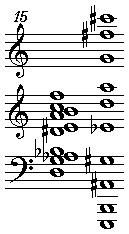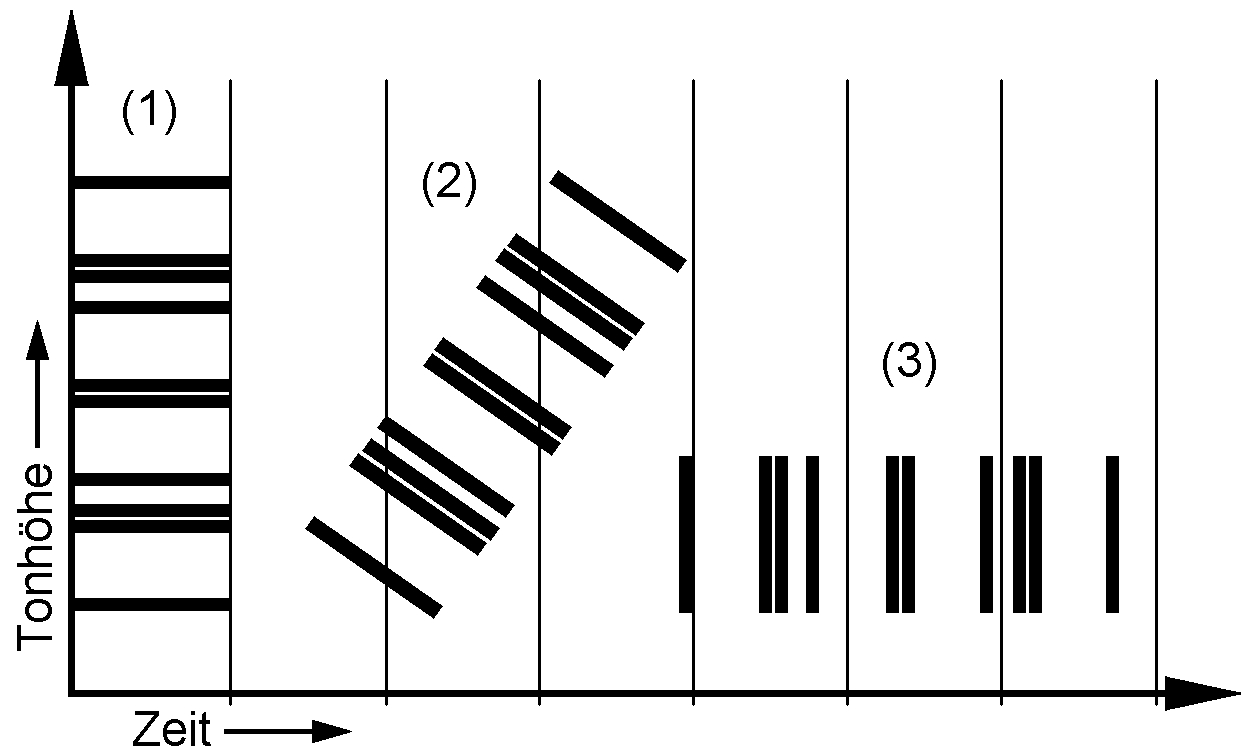|
|
→ Performances and Review
Am On The Verge, Concentric
music for percussion, string quintet and orchestra
ca. 16 Min.
comp. 1990, FP: 1991
→ Download pdf 2141 kB
→ Video with score, recording 1991 Leverkusen, → Robyn Schulkowsky - perc,
→ Bayer Philharmoniker,
→ Rainer Koch - cond.
awarded of the
Kulturkreis der Deutschen Wirtschaft im BDI
and the Gesellschaft für Neue Musik 1991
orchestra: 3. (1. & 2. also Picc, 1. also Organ-Pipe) 1. cor angl. 3. (1. also l.As-clar, 3. also bass clar) 2. (2. also kfag) / 4.3.2. kb-tbn 1./ solo-perc (3 bass dr., Snare, ten.dr., 4 tom-tom, 4 woodblock-dr., 4 wood-tom-tom) timp, glsp, hp / Str-Qui: 2.1.1.1./ Str
Introduction
The postwar generation has left us with a peculiar heritage. The claim of “avant-garde” and the accumulation of quality criteria, which have been shaped
more by theoreticians than by composers of the “Neue Musik”, seem highly questionable since they have not been proven. As a result this has lead to a
situation in which listeners can no longer trust their ears, in which conversation about music is no longer possible, and in which demand for meaning
and the actual social pertinence diverge tremendously.
One source of misunderstanding seems to me the phrasing of the Adorno School on “musical material” and its historical development.
First of all this phrasing is directed against an unhistorical perception of music, which assumes that there exists an absolute position outside of the
human society and history, from which one could create music. This is of course a misguided perception. At the same time a new “absolute” position was
phrased, which associates itself with the term of progress of the bourgeois and capitalistic society, as if art itself could not reflect this very
perception of progress. Although the omnipresence of music history nowadays has obviously suspended the idea of progress, it is not unnecessary to discuss
both mentioned positions, since both continue being relevant.
Basically, it deals with the question of separating or uniting reasoning and feeling.
Thereby, in my opinion the distinctiveness of music lies in the inseparableness of both of these aspects. Music should neither be taken as a complete
matter of emotion, in which intellectual, structural, constructive, or mathematical questions play no role at all, nor can music be reduced to this
question. In both cases the essential would be lost, and in our present time we encounter such examples of amputated music again and again.
I therefore endorse the traditional criteria of the inexhaustible feature of art, which says that the senses and the intellect are both stimulated
in the same way by a piece of art. Further it says that the total is more than just its separate pieces, which is why there are always new discoveries
possible. Thus, I do not consider it possible to govern a compositional progress exclusively in a rational way.
Therefore, whatever I report here about my own compositions, are always partial aspects, and these are of course the aspects which are more likely to
put in words. These are the structural and rational levels of the composition, and these are probably not even the crucial aspects of a composition.
Thus, I am curious to find out what other people discover in my compositions, and I look forward to feedback.
In “am on the verge, concentric” I have primarily dealt with three musical areas.
 The composition is based on a simple structure:
The composition is based on a simple structure:
5-1-2-5-1-5-2-1-5, which may be understood as an interval, as well as a rhythmic series. Taken as an interval series it results in a symmetric chord
of 10 notes, which also occurs in a reverse form:
7-11-10-7-11-7-10-11-7.
Similar to the procedure I employed diminutively with the violoncello in the composition Aposiopesis, I will occupy myself here with the idea of sounds
plunging into time and time itself conflating into sound. Herewith I combine the traditional procedures of variations - such as inversion, retrograde,
diminution, and augmentation - regarding time and interval in such way with each other, so that the dimensions of notation pitch (vertical) and rhythm
(horizontal) confuse with each other on all intermediate stages of tonal and rhythmic dispositions.

A chord (1) thus becomes an event of declining, in turn continuously higher setting in glissandi (2), or a rhythmic sequence of equal clusters (3).
In my composition I employ this principal, which is simplified here, in a far more complex pattern unto five orchestral parts. Thereby I aim at a
developing inner connectivity in which each musical point carries in itself the possibility of alteration on the track of a space-time-ellipse.
Each one of these five parts has its own liberated ‘wolves’ so to say.
At the beginning and at the end stand both chords as stationary tones with a color-coded internal structure.
The intermediate parts between these two chords, especially the drum solo and the solo of the string quintet, are attained from the rests which arise
from the excessive rotations.
Secondly, I occupy myself with the internal arrangement of static tones. The following methods are the ones which repeatedly recur within the composition:
dynamic changes within a tone, stressing and masking of individual tonal elements, timbral changes through detachment of instruments, internal movement due
to different forms of vibrato, and alteration of the sound elements. Often such internal movement is understood as a psychological moment. I interpret it
quite different: the perception of living in a world which does not perform overdue changes since the steady states cannot be overcome; a world which is
full of frantic and unsustainable contradictions, still in which nothing changes. At the time of the composition this perception was intermingled with my
personal situation five years earlier when I had switch from being a carpenter to the studies in music and composition. Although this was an essential and
profound change for me I still witnessed similar restrictions at university, music school and in the world of music, which I had fled from as a carpenter.
These restrictions dissimulated any kind of open perception due to their only interest in classification and allocation of functions. Back then I stated
that “one is incapable of listening and gaping, unable to incur in confusion, one cannot discover anything new, nor strange, or affecting.”
The main interest of the above described structure is to depict such state of rigidity, in which it bubbles and seethes, in a musical way.
Finally, the play forges a bridge of tempo relations 12 : 9 : 4 : 8 : 12.
Thus, the individual parts, which are related to each other due to their internal substance, incur into a tense which becomes compulsive and at the same
time sets them apart. Such tempo relations in the piece, which were also employed on the piano piece “Tagtraumgewölbe”, arise from the worldly perception
of the concurrence of different velocities, and in my opinion stand for the intensive connection with the state of rigidity of static chords.
The encounter and development of the piece with Robyn Schulkowsky and the Bayer orchestra was naturally a profound and formative experience. Further being
awarded with the prize for composition by the cultural circle of the German industry in the BDI and the society for new music was a wonderful affirmation.
Performances
First performance:
1991 November 14th: symphony concert of the
→ Bayer Philharmoniker, Erholungshaus Leverkusen,
→ Robyn Schulkowsky - percussion, Bayer Philharmoniker,
→ GMD Rainer Koch - conduct.;
recording: Tonstudio op. 80, Torsten Wintermeier, Frankfurt am Main 1991
Further performances:
1991 Nov. 15th: Repeat of Nov. 14th
1992 February 16th: Public final rehearsal and
1992 Februar 17th and 18th: symphony concert of the Oldenburgisches Staatstheater;
→ Axel Fries - percussion,
→ Oldenburgisches Staatsorchester,
→ Georg Schmöhe - conduct.
Broadcast:
1993 October 27th: Radio Bremen 2
Review
Nordwest-Zeitung 1992, Febr. 19th, about the concert at 1992 Febr. 17th
Composers from Oldenburg in the 6. concert of the Staatsorchester
Works of Schmidt-Mechau, Poser, Berlioz and Brahms
by
→ Werner Matthes
Oldenburg. (...) Friedemann Schmidt-Mechau’s “am Rande bin, konzentrisch“ - music for percussion, string quintet and orchestra, which was awarded
with the prize of the cultural circle in the BDI of the German industry last year - was “worked“ quite different, but premiered not less artistic
in Oldenburg. Extreme tensions and contrasts, static portions and recurring breaks as a structuring method, musical formulation with the impression
of border crossing, separation and isolation, but also integration define the contradictory portray of a piece, which experiments with dissonant
ligatures, clusters, and double chords; the piece charges these emotionally, forms them into chord gestures (mostly into descending glissandi),
just to make them come alive as metaphors for dreams or for the contemporary sufferings. Friedemann Schmidt-Mechau develops therein an art which
appears suggestive, makes concerned and which partly annihilates and partly emphasizes the wanted anti-dramatic, detailed and episodic tone of
the piece. Axel Fries was the virtuosic agent on the percussion; Georg Schmöhe conducted the major cast of the Oldenburger orchestra with utmost
prudence which was indeed necessary. (...)
|
 The composition is based on a simple structure:
The composition is based on a simple structure: